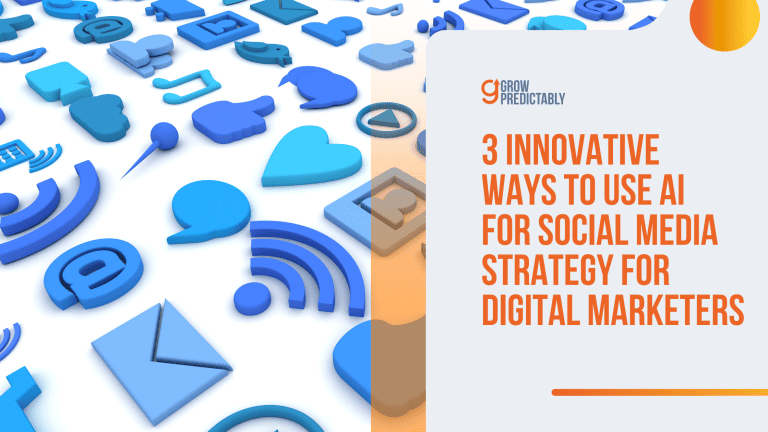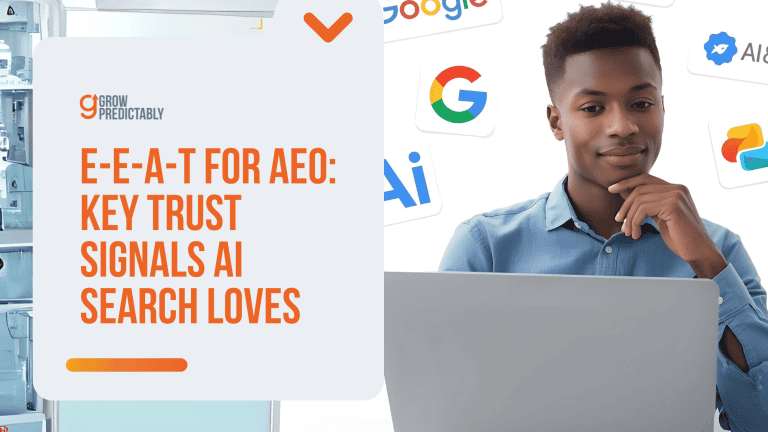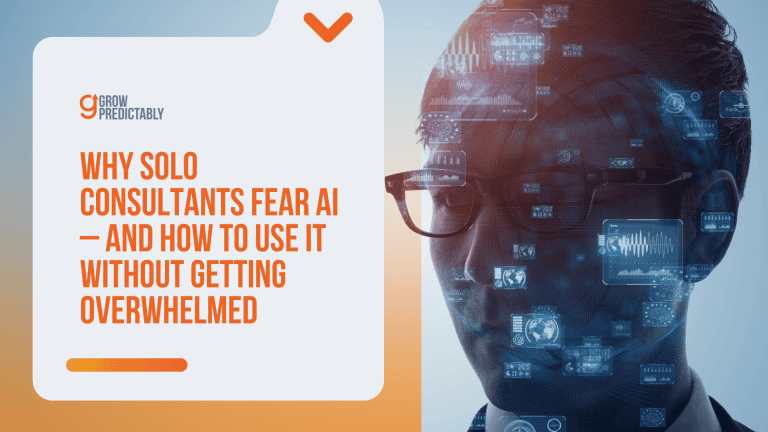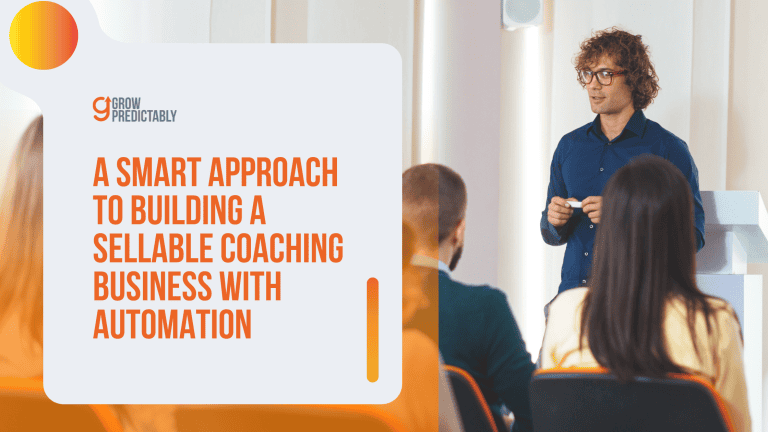Top 5 AI Misconceptions Sabotaging Your Coaching Business
Are you tired of hearing that AI automation will make your high-ticket coaching business feel robotic, impersonal, or even threaten your role?
Let’s clear the air.
The biggest thing standing in your way isn’t the tech—it’s the old beliefs about it.
Here’s the reality about AI automation myths for high-ticket coaches: AI isn’t here to replace your client transformation or intuition, it’s here to eliminate the boring admin work so you can focus on real coaching.
When you break free from these myths, you’re not just saving 8–12 hours a week—you’re also boosting client capacity, scaling your revenue up to 30%, and delivering an even more premium experience that your clients will love.
The secret?
Using the right tools in a way that supports—not replaces—your unique coaching style.
Your clients are ready for a coaching experience that feels both personal and friction-free.
Let’s unlock your next level of growth—together.
TL;DR
Business coaches often sabotage their growth by believing myths about AI, such as fear of AI replacing them or ruining personalization. Embracing AI can enhance coaching by managing routine tasks, allowing coaches to focus on client transformation and deepen connections.
KEY TAKEAWAYS
- Identify and dispel common AI myths that limit your growth potential, such as concerns about cost, complexity, and loss of personal touch.
- Start with small automations like client scheduling and follow-up emails to gradually integrate AI, freeing time for meaningful coaching interactions.
- Recognize AI as a supportive tool that complements your coaching, enhancing the client experience and enabling scalability without sacrificing your unique expertise.
What AI Automation Myths Are Holding Back Coaches?
Could your coaching business actually feel more personal with automation?
That question might sound contradictory, but what if the fears keeping you from embracing AI are the very things holding back your deepest client connections?
Let’s pull back the curtain on five myths that might be quietly limiting your coaching practice’s growth and your ability to serve clients at the highest level.
Myth #1: “Will AI replace me as a coach?”
When you hear about AI writing emails or generating content, it’s natural to wonder: “Am I next?”
This fear hits at the heart of your identity as a coach and as a human agent.
But here’s the truth: AI can’t replicate your lived experience, intuition, or the transformational moments you create with clients.
AI isn’t coming for your coaching role as a human agent—it’s coming for the tasks that drain your energy before you even get to coach.
According to a Forbes 2025 resource on AI’s impact on careers, the jobs that will most likely be overtaken by AI are those that ‘machines or software programs can perform without human intervention.’ (Source)
Think of an AI agent as your backstage assistant handling ticket sales while you perform on stage.
The spotlight remains firmly on you, while repetitive tasks happen behind the scenes.
Spending precious hours on admin work that could be spent in deep connection with clients or refining your unique coaching approach.
Myth #2: “Will AI automation destroy the high-touch experience?”
“But my VIP clients expect white-glove service!” I hear you.
The idea of automating parts of a premium experience can feel wrong—like serving microwaved food at a five-star restaurant.
Yet consider this question: What if automation actually creates more space for personalization and better decision making?
When a system automatically sends your new client their welcome packet with custom journal prompts tied to their specific goals, you’re freed up to record that personal voice note about how excited you are to work with them.
The automation handles logistics while you focus on connection.
Burnout from manually handling every client touchpoint, leaving you with less emotional energy for the moments that truly matter.
Myth #3: “Are AI tools expensive and complex for a coaching business?”
Many coaches picture enterprise-level systems with five-figure price tags and months of setup when they think about automation.
The reality?
Many powerful tools start at under $50/month and can be set up in afternoons, not months.
Tools like Calendly eliminate scheduling back-and-forth for $10-20 monthly.
Many email platforms with automation features start around $30/month.
The question isn’t whether you can afford these tools—it’s whether you can afford to keep manually handling tasks they could do for you.
Staying small when tools within your budget could help you scale, leaving money on the table while working harder than necessary.
Myth #4: “Will implementing AI mean losing control of my coaching?”
There’s something special about how you work with clients—your unique approach that gets results.
It’s natural to worry that bringing in automation might water down your secret sauce or create disconnects in your process.
But automation isn’t about changing your coaching—it’s about amplifying it.
You, as a human agent, program the systems with your voice, your methodology, and your decision points.
Think of it like teaching a trusted assistant your exact process, not replacing it.
Keeping your impact small because you’re the bottleneck for every part of your client experience, limiting how many people you can truly help.
Myth #5: “Does AI require technical expertise and huge time investments?”
“I’m not tech-savvy” might be the most common objection I hear from coaches considering automation.
The thought of learning new systems while running a business feels overwhelming.
Today’s AI tools are designed for non-technical users.
Many use simple drag-and-drop interfaces or template systems.
You don’t need to code or understand natural language processing—you need to know your process and what you want to accomplish.
The initial setup might take a few hours, but those hours create systems that save you hundreds of hours over time by utilizing an AI agent.
Could you dedicate one afternoon to save 5 hours every week going forward?
Staying stuck in the time-for-money trap, eventually hitting income ceilings because there are only so many hours in your day.
What are the real costs of holding onto these automation myths?
Holding onto automation myths costs you efficiency, impact, and revenue, ultimately limiting your coaching practice’s growth.
Without leveraging AI for routine tasks, you’re risking:
- Plateaued client capacity, which directly affects your income potential.
- More time on low-value work rather than high-impact coaching, diminishing your effectiveness.
- Increased burnout risk as you try to scale manually instead of strategically.
- Inconsistent client experiences when you’re stretched too thin, impacting client satisfaction.
Thriving in the coaching industry means blending human expertise with AI’s supportive capabilities.
The coaches of tomorrow will be those who embrace technology, using it to enhance, not replace, their human touch.
Now that we’ve cleared the air on these common fears, let’s explore how you can practically implement automation—without losing your voice or values.
The next section will show you exactly how AI can enhance your coaching practice while keeping you firmly in the driver’s seat.
How Does AI Automation Enhance High-Ticket Coaching Without Losing the Human Touch?
“I built my coaching business on deep connection and personalized guidance. If I start using AI, won’t my clients feel like they’re getting a watered-down version of me?”
This fear echoes through the coaching world.
You’ve poured your heart into creating transformative experiences for your clients.
The thought of introducing automation feels like inviting a robot to a heart-to-heart conversation.
But what if that’s not what’s happening at all?
How AI Works Behind the Scenes
Think of AI as your dedicated backstage crew—not the star of the show.
While you’re center stage creating breakthroughs with clients, AI handles the background operations that drain your energy and fragment your focus.
You’ve just finished a powerful coaching session. Your client is buzzing with insights and ready for action.
Therefore, instead of spending the next hour manually sending follow-up materials, updating your CRM, and scheduling the next session, your AI agent has already:
- Delivered the custom workbook to your client’s inbox
- Updated their progress in your system
- Sent a scheduling link with your available times
- Triggered a payment reminder for their next installment
You’re free to jot down personal notes about their breakthrough while it’s fresh in your mind, or prepare deeply for your next client.
You see, when AI and automation enters the frame in your coaching service, this brings you redemption.
Redemption in reclaiming your energy and time that repetitive tasks typically take away from you.
According to one Forbes resource, AI and automation enables your coaching many things aside from just time savings. (Source)
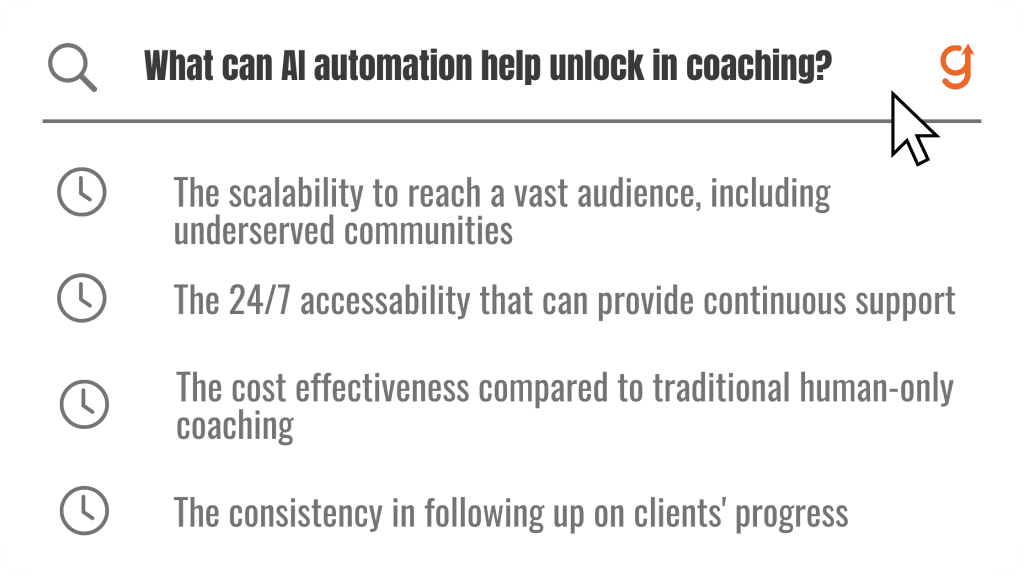
What Could You Do With The Extra Hours?
Based on a Forbes research that explores how AI impacts time savings at work, 58% of the employees surveyed report nearly 5 hours of time savings every week. (Source)
What would you do with that time?
- Develop new coaching frameworks unique to your methodology
- Create deeper preparation for each client session
- Take care of yourself so you show up fully present
- Host more discovery calls to grow your business
You’re not using AI to replace your coaching. You’re using it to make sure more of your time goes to actual coaching.
Where Does Automation Meet Personal Touch?
The most successful coaches use a hybrid approach—knowing exactly where to automate and where to add personal touches:
🔄 Automation Zone: Client scheduling, payment processing, resource delivery, session reminders
👤 Personal Zone: Strategy sessions, feedback on work, celebration of milestones, customized guidance
For example, a high-performance coach might use HubSpot to automatically track when a client completes a milestone worksheet.
This triggers two things:
- an automated email delivering the next resource
- a notification to the coach to send a personal voice note of encouragement through Voxer.
The client receives both the efficiency of immediate resources and the irreplaceable warmth of their coach’s personalized encouragement.
Will Automation Diminish the Client Experience?
Interestingly, here’s what might surprise you: clients often report feeling more supported with thoughtful automation in place.
Why?
Because:
- They never fall through the cracks between sessions
- Resources arrive exactly when needed, not when you find time
- Administrative friction disappears, creating a premium experience
- You’re less drained and more present as a human agent during actual coaching time.
Before automation, it might take clients days before receiving session recordings; with automation, they receive them automatically within hours.
They feel more valued, and it helps you stop worrying about your admin backlogs as a coach with the help of an AI agent.
Will Automation Only Improve Time Savings?
The benefits extend beyond reclaiming your time:
- Consistent Client Experience: Every client receives your best systems, not your varying energy levels, which enhances customer satisfaction!
- Scalable Business Model: Add more clients without proportionally increasing your workload
- Reduced Mental Load: Stop carrying every client detail in your head
Is Automating Everything Necessary?
You don’t need to automate everything at once.
Start with one friction point that drains your energy:
- Post-session follow-ups
- Pre-session preparation reminders
- Resource organization and delivery
- Payment processing and receipts
Each small automation builds your confidence while preserving what makes your coaching special—your wisdom, intuition, and personal connection.
AI helps you deliver personalized value at scale—without burning out or compromising the premium experience your clients expect.
The question isn’t whether automation will diminish your coaching magic; instead, it is about how much more magic you could create when freed from administrative burdens.
Now that we’ve seen what’s possible, let’s discover exactly how to implement these systems without overwhelming yourself or your business.
How to Implement AI Automation in Your Coaching Business in 5 Steps?
Ready to bring AI into your coaching practice without losing what makes you special?
I’m excited to walk you through this journey!
Let’s break down how to implement automation in ways that actually enhance your coaching presence rather than replace it.
Step 1: Map Your Client Journey
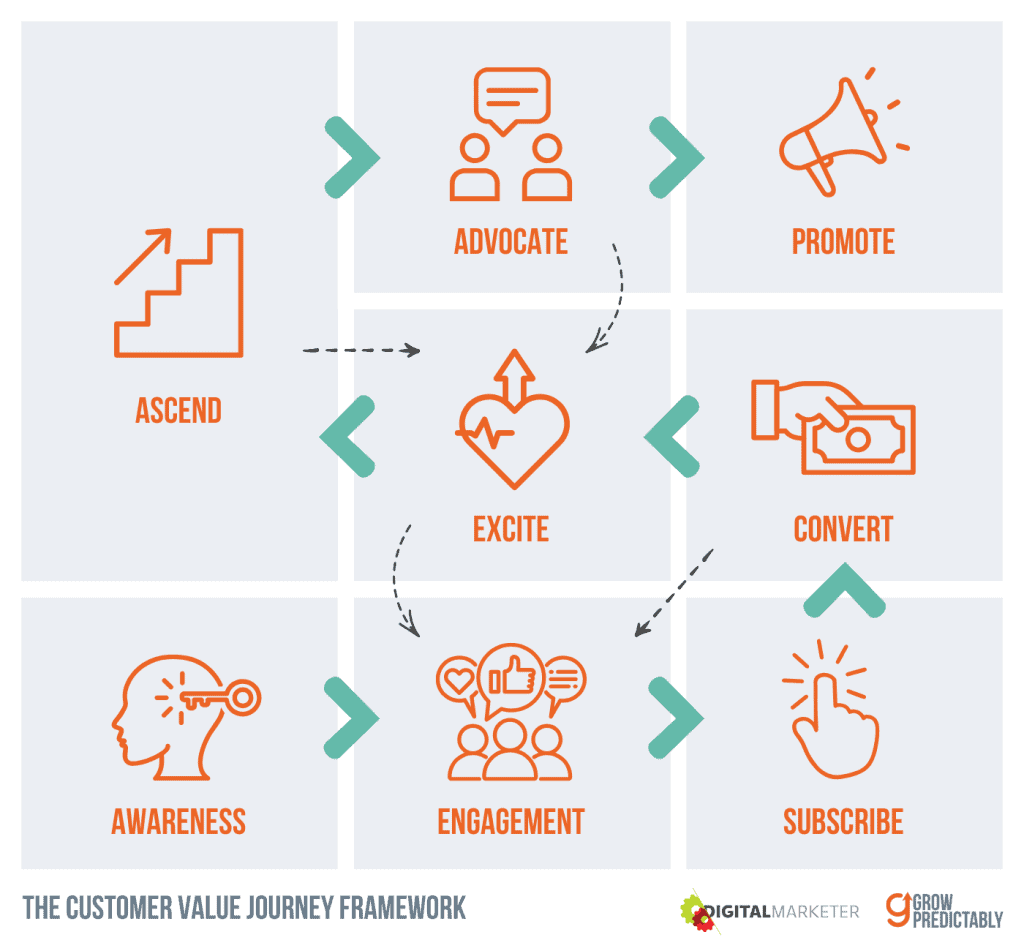
Think of your client’s experience as a customer journey, with many chapters.
Where does it begin? Furthermore, how does it unfold? What happens after they finish working with you?
According to the Hanover 2022 research “The Power of Customer Journey Mapping,” 76% of companies that leverage data from customer journey mapping ‘has increased the ROI of their business investments and allowed them to become more customer-centric.’ (Source)
To begin mapping your customer journey, start by drawing out every single touchpoint your clients experience—from the moment they discover you through their transformation and beyond.
Look for patterns where you repeat the same actions over and over:
- Sending welcome emails
- Scheduling discovery calls
- Following up after sessions
- Delivering resources and materials
- Checking in between sessions
These patterns will usually show you the touchpoints that automation can take over.
Focus on identifying stages where automation would support—not replace—your personal presence.
The goal is to automate the routine so you can elevate the remarkable.
Step 2: Choose Coach-Ready Tools
You don’t need to become a tech wizard!
These user-friendly tools are designed with coaches in mind:
- ActiveCampaign: Creates email sequences that respond to how engaged your clients are. Sends different content based on whether they opened previous emails or clicked specific links.
- Calendly: Ends the back-and-forth scheduling nightmare. Shows only your available times and lets clients book instantly, then adds sessions to your calendar.
- Notion: Organizes all your client notes, resources, and frameworks in one searchable hub. Create templates for session prep that save you hours of repetitive setup.
- Zapier: The magic connector! Links your different tools together so when something happens in one (like a form submission), it triggers an action in another (like adding the person to your email list).
Pick just one or two to start—you can always expand later!
After Steps 1 and 2, you’re already halfway to supercharging your coaching business with the benefits of AI automation.
Step 3: Start Small with “Invisible” Wins
Begin with behind-the-scenes processes your clients barely notice but that free up significant mental space for you:
- Payment confirmations: Automatically thank clients and provide receipts when payments process
- Resource delivery: Set up systems that send workbooks, audio recordings, or journal prompts after sessions
- Session reminders: Send automated prep questions 24 hours before coaching calls
- Follow-up emails: Schedule thoughtful check-ins to arrive 3 days after intense breakthrough sessions
Here’s an example of how a basic payments processing can be automated.
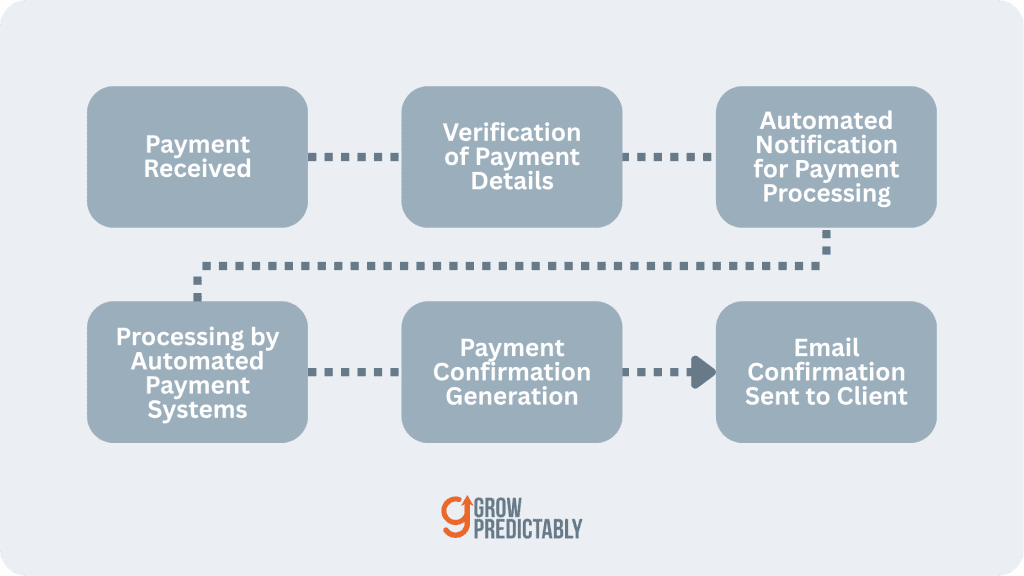
These small automations build your confidence while preserving your unique voice and approach.
They’re the perfect starting point because they handle administrative details without touching the heart of your coaching relationship.
Write these messages in your natural voice, then let the system deliver them at the right time.
Your clients get consistent support while you focus on transformation work.
Step 4: Align Workflows to Your Brand
This step is crucial!
Make sure your automated communications feel like they come from you—not a robot.
Take time to:
- Review the tone and language in all automated messages
- Adjust the timing between touchpoints (too many emails too quickly feels pushy)
- Add personalization fields that include client names and specific details
- Test the full sequence yourself to experience what clients will receive
Create hybrid touchpoints that combine automation with personal connection.
For example, use Voxer to send a quick voice note after your system automatically delivers a workbook.
Here, the automation handles the logistics, while your voice adds the personal touch.
Step 5: Expand & Evaluate
Once your basic automations are running smoothly, look for opportunities to grow:
- Lead nurturing: Create sequences that guide potential clients from free content to paid offerings
- Content repurposing: Use AI tools to transform your coaching sessions into blog posts or social media content (with client permission)
- Progress tracking: Implement automated check-ins that gather data on client progress
Track key metrics, especially customer satisfaction, to understand what’s working:
- Hours saved per week
- Client satisfaction ratings
- Conversion rates from prospects to clients
- Your own energy levels and focus during sessions
Remember: you’re enhancing your presence, not erasing it.
Therefore, start with tasks that drain your energy—not the ones that build relationships.
The goal is to spend more time doing the transformative work only you can do.
By following these steps, you’ll create systems that help you deliver exceptional coaching while growing your business sustainably.
The beauty is that your clients won’t think “wow, great automation”—they’ll think “wow, my coach is incredibly attentive and organized!”
Ready to take that first step?
Look back at your current client journey and identify just one repetitive task you’d love to automate this week.
Your Next-Level Automation Checklist
As you expand, consider these questions:
- Which part of my client journey still feels unnecessarily manual?
- What questions do I answer repeatedly that could be pre-addressed?
- Where do clients seem to need more support between our sessions?
- Which tasks drain my creative energy that don’t actually require my personal touch?
Remember this: you’re not replacing your coaching magic—you’re amplifying it by removing the busy work that dilutes your impact.
Start with small automations, measure their impact, and gradually expand to create a coaching business that scales without sacrificing quality.
How to Responsibly Use AI for High-Ticket Coaching?
Adopting AI in your coaching practice requires a balance between innovation and integrity.
Here are some key considerations to ensure responsible AI use:
1. Client Confidentiality
Always prioritize the privacy and security of client data. Use AI tools that comply with data protection regulations and have robust security measures in place.
Encrypt sensitive information and limit AI access to non-critical data.
- Conduct regular audits to ensure that all data handling practices meet industry standards.
- Train your team on compliance requirements to prevent data breaches.
2. Transparency
Keep the lines of communication open with your clients about how AI is utilized.
Explain its role in your services, such as automating scheduling or generating session summaries, and reassure them that personal aspects of coaching remain human-driven.
- Develop a clear communication plan to introduce AI tools to clients.
- Create FAQs or guides that address how AI supports their coaching journey.
3. Ethical Alignment
Ensure that your AI implementations align with your core values.
For instance, avoid using AI solely for upselling without genuine client benefit.
The goal is to enhance client experiences, not focus merely on profits.
- Establish a set of ethical guidelines to evaluate new AI tools.
- Regularly assess AI outcomes to ensure they support client development.
4. Continuous Monitoring
Regularly review AI systems for performance and ethical compliance.
Invite client feedback on automated processes to identify areas for improvement.
Responsive adaptation fosters trust and maintains high service standards.
- Schedule bi-annual reviews of AI system performance to identify potential issues.
- Implement a feedback loop with clients to gather insights and adapt accordingly.
How to Balance Automation and Personalization in Coaching?
How could integrating AI technology make your coaching practice more personal?
Let’s explore how you can maintain your unique coaching presence while you integrate AI to handle the repetitive work that drains your energy.
Picture this: You’ve just finished an amazing coaching session.
Your client had a breakthrough moment that reminded you why you do this work.
Then you spend the next 90 minutes updating spreadsheets, sending follow-up emails, and scheduling the next appointment.
That energy drain is real! And it’s exactly where AI shines.
The key is knowing where to draw the line.
What deserves your full, undivided attention, and what can be handled by your “backstage crew”?
Here’s how to find that balance:
Why is AI Analytics Important to Personalization?
Tools like HubSpot can track client engagement patterns—which resources they’ve opened, what topics they’ve expressed interest in—and help you tailor your approach accordingly.
For example, if your client consistently engages with content about public speaking but ignores leadership materials, your next session can focus on their clear priority without them having to explicitly tell you.
This is just an example of how better insights can help you level up your personalization.
Create Hybrid Touchpoints
Remember, automation doesn’t mean “all or nothing.”
The most effective approach combines both:
“I automated my client onboarding sequence, but I follow it with a personal video welcoming them to the program. My clients tell me it feels even more special because they get immediate resources plus a personal touch.”
This hybrid approach often creates a better experience than either fully manual or fully automated systems.
Take a look at a few more of these examples below…
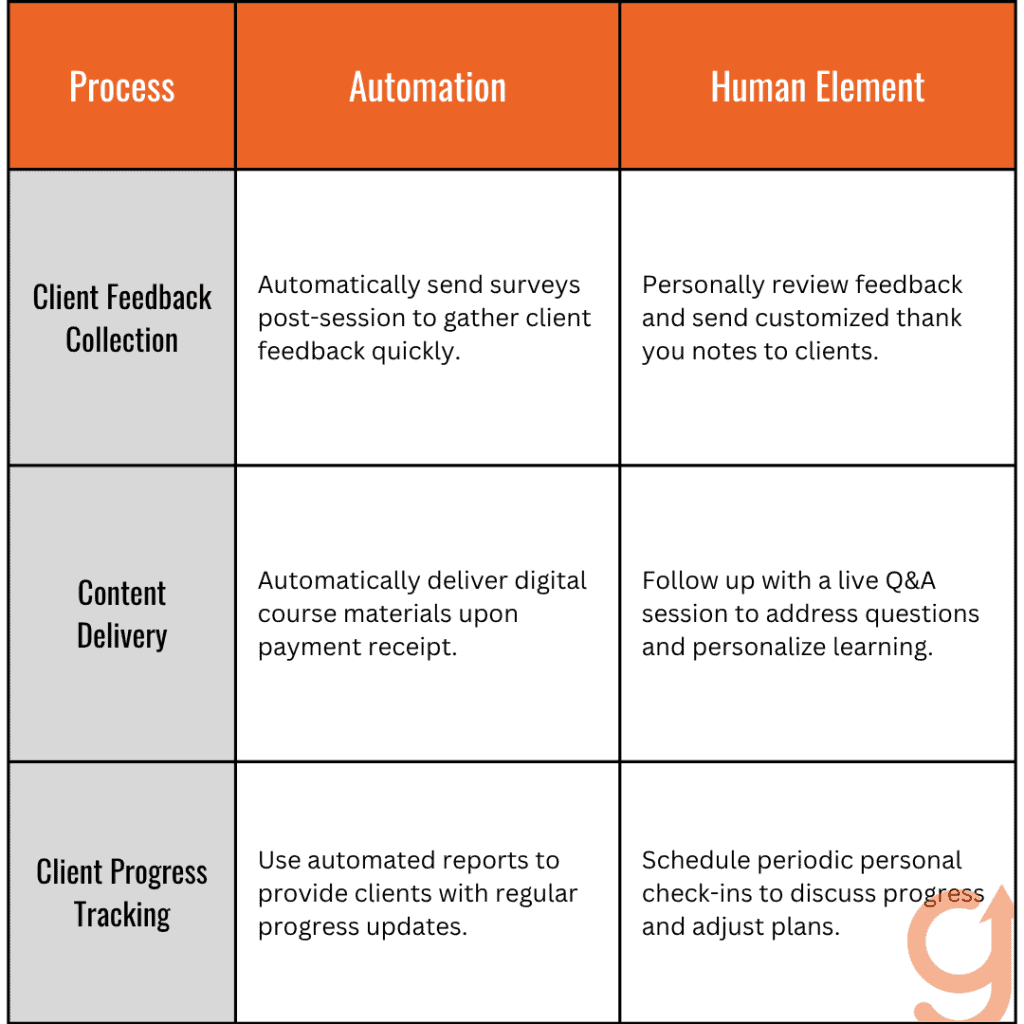
Define Your Automation Boundaries
Again, not everything should be automated.
Consider this framework:
What You Can Automate
- Scheduling and rescheduling sessions
- Payment processing and reminder flows
- Entry-level funnel content and resource delivery
- Progress tracking and milestone celebrations
- FAQ responses for common questions
What You Should Keep Personal
- Coaching sessions and strategy discussions
- Deep diagnostic conversations
- Emotional check-ins and support moments
- Personalized feedback on work or challenges
- Celebration of major breakthroughs
Consider this: “Will implementing automation in this area improve or reduce the quality of the client experience?”
How Does Your Voice Elevate Each Touchpoint?
Even in automated systems, your unique voice should shine through.
Try this exercise: Write down 5-10 phrases you naturally use with clients.
These become your “voice anchors” that you can weave into automated communications.
A coach I am acquainted with concludes every session by saying, “Always keep in mind that progress is more valuable than striving for perfection.”
She made sure this phrase appeared in her automated check-in emails, maintaining consistency between her live coaching and automated touchpoints.
Client Perception Is Everything
Here’s what most coaches miss: Clients don’t judge you based on which tools you use—they judge you based on how supported they feel.
Does your clients feel seen, heard, and supported between sessions?
If the answer is yes, you’re succeeding—regardless of whether that support comes directly from you or from well-designed systems.
How to Start Your AI Automation Journey As a Coach Today?
Ready to put AI to work for your coaching business?
Let’s get you started with practical tools and clear first steps that won’t overwhelm you.
The journey of a thousand miles begins with a single automation!
🧰 Recommended AI Tools for Coaches
- Calendly: End the back-and-forth scheduling headache. Your clients book directly into your calendar based on your actual availability—no more email tennis!
- Jasper: Generate content ideas, email templates, and session prep questions tailored to your coaching style. Perfect for creating consistent client touchpoints between sessions.
- ActiveCampaign: Build email sequences that nurture leads and support clients through their journey. Set up once, then watch as it delivers personalized content at just the right moments.
- Notion: Keep all your coaching frameworks, client notes, and resources organized in one searchable hub. Create templates for session prep that save you hours each week.
- Zapier: Connect your favorite tools so they talk to each other! When a client books a call, automatically send them prep materials and add a reminder to your task list.
📝 Take Your First Steps Today
Don’t just read about AI—experience how it can transform your coaching practice!
Here are three ways to move forward as a human agent:
1. Download our Self-Assessment: “Which Coaching Tasks Should You Automate First?”
This quick quiz helps you identify your biggest time-drains and matches them with the right automation solutions for your specific coaching style.
2. Join our live webinar: “AI for Human-Centered Coaches”
See real examples of how AI works to help coaches just like you who’ve doubled their client capacity without sacrificing quality.
We’ll walk through actual automation setups you can copy.
3. Book a discovery call to get a personal automation roadmap
Let’s look at your unique coaching business and create a custom plan that respects your values while boosting your efficiency.
FAQ
Unleash the True Potential of Your Coaching Practice
To sum up, automation and AI are not threats—they are powerful allies that remove friction and elevate every stage of your client journey.
By letting go of the five most persistent myths, you gain capacity to serve more, love your work again, and deliver even higher value.
At the heart of great coaching is meaningful human connection.
When you free yourself from repetitive tasks, you multiply your ability to inspire and support.
The time to act is now.
Take the next step: Book a discovery call, join our community of coaches, or explore the tools and checklists provided.
What’s one small win you can automate to feel more energized and available for deep client breakthroughs?
How will your business—and your impact—grow when you stop working harder and start working smarter?
The ripple effects go far beyond your practice—they transform the entire coaching industry for the better.



